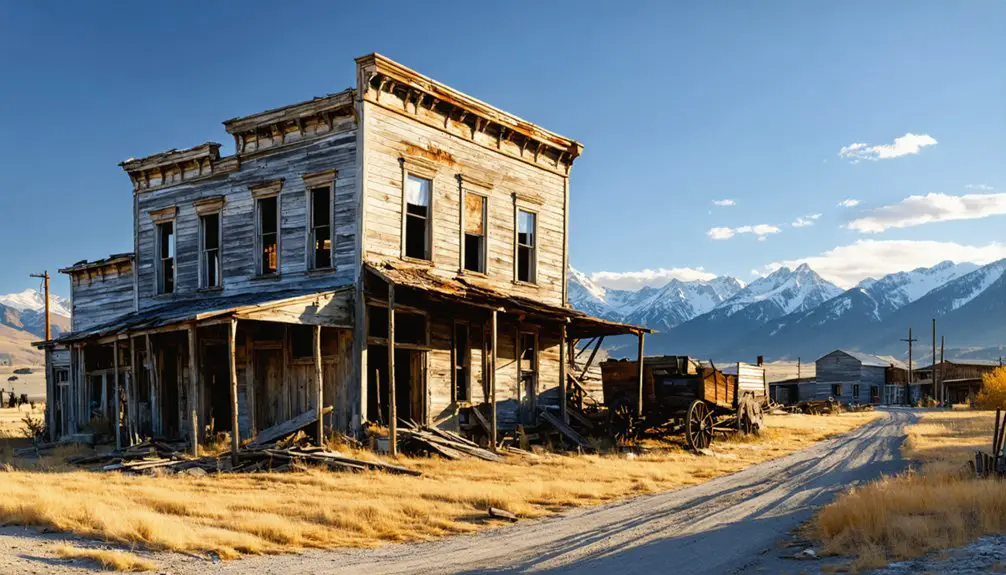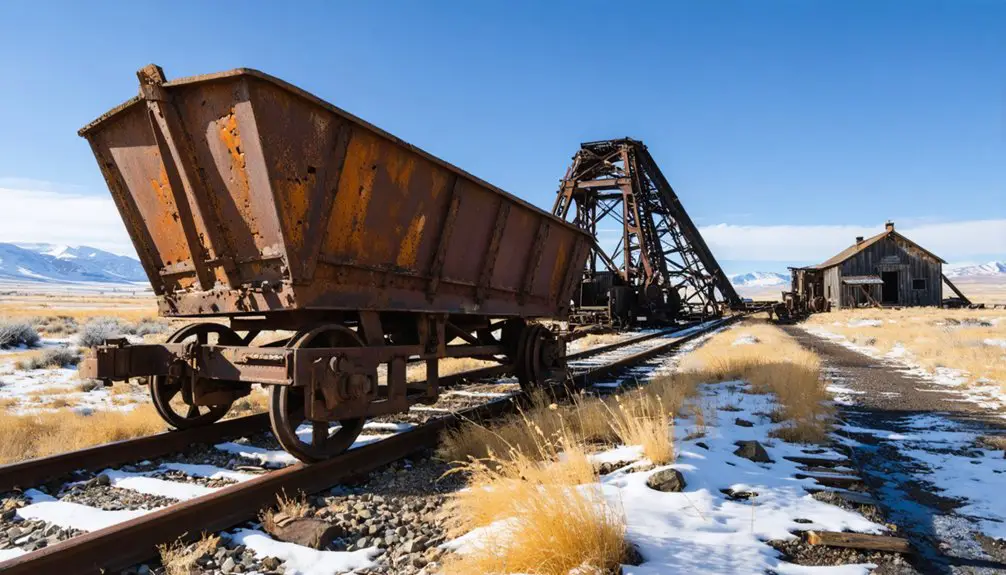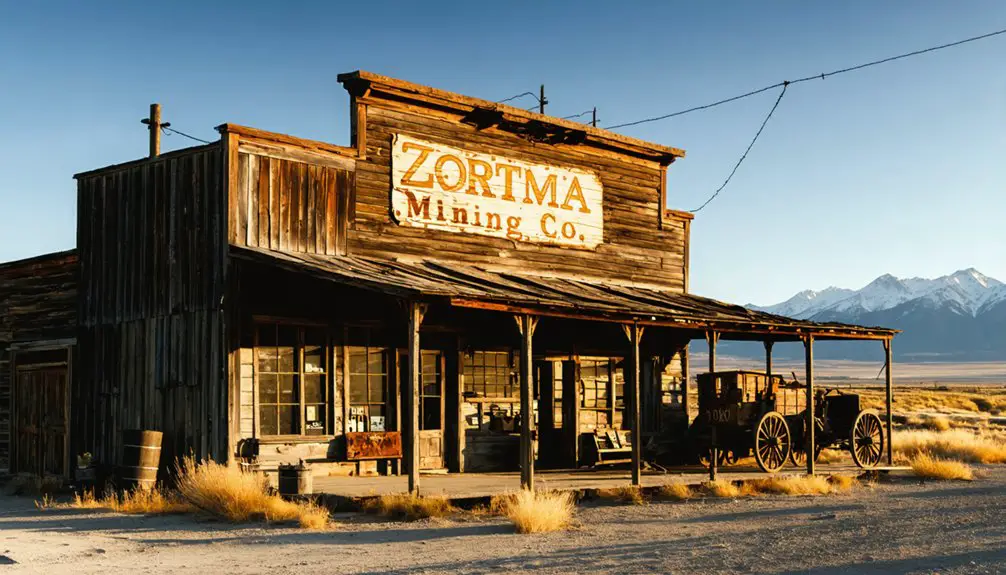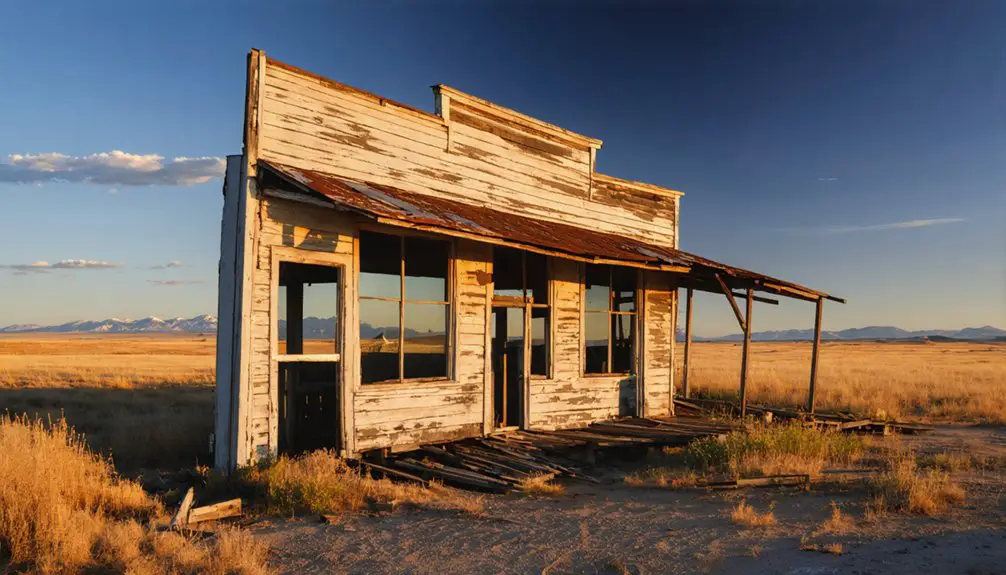You’ll discover the remains of Zortman, Montana’s most innovative gold mining town, where revolutionary cyanide processing once produced $14,000 in gold bullion daily. The town peaked at 2,000 residents in the 1920s, boasting nine bars, a hospital, and two schools. After devastating fires, wars, and Pegasus Gold’s 1998 bankruptcy, Zortman became a ghost town. Today, crumbling structures and mining ruins tell tales of lost fortunes and environmental challenges that shaped Montana’s mining legacy.
Key Takeaways
- Zortman was a thriving gold mining town in Montana’s Little Rocky Mountains that peaked at 2,000 residents in the 1920s.
- The Ruby Gulch mine dominated local gold production, using innovative cyanide leaching to process $14,000 in gold daily.
- Nine bars, general stores, a hospital, and two schools formed the backbone of this bustling mining community.
- Environmental issues from cyanide heap leaching and acid rock drainage led to extensive cleanup costs exceeding $83 million.
- Today, visitors can explore crumbling structures, mining ruins, and hiking trails in this authentic Montana ghost town.
Gold Discovery and Early Settlement

While Native American tribes had long known of gold deposits in Montana’s Little Rocky Mountains, formal prospecting didn’t begin until the late 1860s.
Indigenous relationships became strained as miners encroached on traditional tribal lands, with the Gros Ventre and Assiniboine peoples trying to protect their ancestral territory from the influx of prospectors.
The first major breakthrough came in 1884 when placer gold was discovered at what would become Zortman.
The real turning point occurred in 1890 when Pike Landusky and Bob Ormond struck rich veins near the future townsite.
Named after Oliver “Pete” Zortman, the settlement quickly grew as miners flooded the area. The Ruby Gulch mine became the town’s most profitable operation, generating up to $14,000 in gold each day by 1904.
This discovery led to significant land displacement of Native peoples, culminating in the 1895 Grinnell Agreement that forced tribes to sell their gold-rich lands to the government. In 1855, the Fort Belknap Reservation was established as the new home for the displaced Assiniboine and Gros Ventre tribes.
Mining Boom and Industrial Growth
In 1904, you’d find Pete Zortman’s Ruby Gulch mill revolutionizing gold extraction through cyanide leaching, becoming the world’s second-largest facility of its kind and producing up to $14,000 in gold bullion daily.
By implementing this innovative technology to process previously unprofitable low-grade ore, mining operations expanded rapidly across the Little Rocky Mountains, extracting over 308,000 ounces of gold throughout the district’s lifetime.
You’d witness Zortman’s population surge to 2,000 residents by the early 1920s as the mining boom brought unprecedented prosperity, supporting nine bars, multiple stores, hotels, schools, and other essential services.
Gold Rush Production Peaks
Montana’s gold production reached remarkable heights during the late 19th century, with Alder Gulch alone yielding 1.4 million ounces valued at $30 million between the 1860s-70s.
While placer mining dominated the early rushes, you’ll find that lode mining soon became the primary source of gold production across many districts.
The state’s mining peaks brought waves of prosperity and development:
- Major districts like Butte, Helena, and Virginia City each produced over a million ounces
- The North Moccasin District near Lewistown yielded 450,000 ounces from lode mines
- Post-1934 price increases sparked renewed mining activity
- Late 1980s saw another production surge with modern processing methods
The introduction of mining dredges in 1890 revolutionized placer mining operations and extended the productive life of many mining areas throughout Montana.
The Confederate Gulch district produced exceptional yields, generating between $1-1.5 million from its rich Montana Bar deposits.
Mining Technology Advances
The technological revolution that transformed Montana’s mining industry paralleled its explosive gold production, as mining operations evolved from simple surface prospecting to sophisticated underground networks.
You’d find remarkable shaft innovations throughout the region, with miners constructing over 49 miles of vertical shafts and an astounding 10,000 miles of horizontal tunnels in Butte alone. The arrival of efficient rail transport dramatically improved the movement of ore and supplies throughout the mining district. Situated atop the rich Boulder Batholith, Butte’s mineral wealth drove continuous technological advancement.
The advancement in ore processing transformed the industry’s efficiency. Local smelters sprouted up by the late 1860s, eliminating costly long-distance transport of raw materials.
The region’s processing capacity skyrocketed, with Butte’s facilities handling 4,000 tons daily and Anaconda processing 2,500 tons.
These improvements, combined with mechanized drilling and enhanced blasting techniques, turned Montana’s scattered mining camps into industrial powerhouses that would define the territory’s economic future.
Booming Population Growth
While Native Americans had long known about gold in the Little Rocky Mountains, it wasn’t until the late 1860s that prospectors began flooding the area, marking the start of Zortman’s remarkable population surge. Similar to the rich deposits found in Gold Creek during Montana’s first gold discoveries, these mountains held immense mineral wealth.
The discovery of rich veins in 1890 by Pike Landusky and Bob Ormond triggered massive residential expansion, transforming Zortman from a mining camp into a thriving town. Like the infamous Montana Vigilantes who brought order to mining communities, Zortman established its own local law enforcement to protect its growing population.
You’ll find these key milestones in Zortman’s growth:
- By 1904, the Ruby Gulch mine was producing $14,000 daily in gold bullion
- Population peaked at 2,000 residents in the early 1920s
- Nine bars, two schools, and a hospital supported economic sustainability
- The town expanded to include markets, newspapers, and recreational facilities
The boom persisted through cycles of fire damage and war-related shutdowns until mining operations finally ceased in 1951.
Daily Life in Peak Mining Years
During Zortman’s peak mining years in the early 1920s, nearly 2,000 residents created a vibrant community centered around gold mining operations.
You’d find nine bustling bars where miners gathered after long shifts, while general stores supplied essential goods to their families. The town’s hospital tended to mining injuries, and two schools educated the children of workers and merchants alike.
Social gatherings often revolved around the white clapboard church and community events, fostering connections among the diverse population. Today, only ruins of buildings remain as silent reminders of this once-thriving mining town.
Beyond the mines, you’d see people filling crucial community roles – from teachers and medical staff to store clerks and delivery workers. Daily life carried on through harsh winters, with the meat market, hotels, and local newspaper serving as foundations of this determined frontier town.
Technology and Mining Operations

As mining methods evolved in Zortman from the late 1800s through the 1900s, you’d see dramatic technological shifts that transformed the region’s gold extraction capabilities.
Early miners started with simple placer techniques before moving to underground tunnels and advanced cyanide processing at the Ruby Gulch mill in the 1920s. By the late 1970s, you’d witness a revolutionary change as Ed Schultz pioneered heap leach technology, making low-grade ore profitable. The mine achieved recognition as the first major heap leach gold operation in the United States.
- Cyanide processing made Zortman’s Ruby Gulch mill the second-largest facility of its kind globally
- Heap leach technology transformed previously worthless rock into valuable ore
- Geophysical mapping helped miners target gold deposits more precisely
- Advanced electrical techniques reduced unnecessary mining of acid-generating sulfides
These innovations kept Zortman at the forefront of mining technology, though environmental challenges would later emerge.
Natural Disasters and Historic Fires
Since its early days, Zortman faced devastating natural disasters that repeatedly threatened the town’s survival, particularly through a series of destructive fires.
You’ll find that the town’s fire resilience was tested repeatedly – first with the 1912 Ruby Gulch mill fire, then another devastating mill fire in 1923.
The most catastrophic event came in 1936 when a massive wildfire swept through the Little Rocky Mountains, crippling mining operations throughout the region.
The devastating 1936 wildfire that raged through the Little Rockies dealt a crushing blow to Zortman’s mining industry.
The town’s economic recovery became increasingly difficult after each disaster.
Zortman’s remote location at 4,000 feet elevation, surrounded by forested mountains near Old Scraggy Peak, made firefighting especially challenging.
These recurring disasters, combined with limited access routes, contributed to the mining community’s eventual decline from its peak population of 2,000 residents.
World War Impact and Mining Decline

World War I and II brought complex changes to Zortman’s mining operations, creating a stark contrast to the earlier challenges posed by natural disasters.
While wartime minerals were in high demand, Zortman’s focus on gold meant limited production impact during these global conflicts. You’d have seen labor shortages affect the workforce, slowing operations as men left for war.
The real decline began in the 1970s when open pit mining introduced new methods but also new problems:
- Cyanide heap leaching contaminated local water sources
- Acid rock drainage damaged surrounding ecosystems
- Pegasus Gold’s 1998 bankruptcy ended large-scale operations
- Environmental cleanup costs exceeded $83 million by 2021
The mining town’s economy collapsed after the mines closed, transforming Zortman into a shell of its former self, with only environmental remediation work providing limited employment opportunities.
Modern Ghost Town Experience
Today’s visitors to Zortman encounter an authentic Montana ghost town experience, where crumbling mining structures and weathered buildings tell the story of its gold rush past.
You’ll find yourself stepping back in time as you explore the remote site, where limited modern amenities and spotty cell service enhance the feeling of isolation.
The town’s rustic character comes alive through self-guided tours of mining ruins and old cabins, while nearby hiking trails offer scenic views.
You’ll want to come prepared, as services are minimal. Local ghost stories and tales of lost gold add an eerie dimension to visitor experiences, especially during quiet evenings.
When combined with neighboring Landusky, you’ll discover a raw, unvarnished glimpse into Montana’s mining heritage, free from commercial tourist trappings.
Frequently Asked Questions
Are There Any Haunted Buildings or Paranormal Activities Reported in Zortman?
You won’t find documented ghost sightings or paranormal investigations in Zortman. While it’s a genuine ghost town with historic buildings and mining ruins, there aren’t credible reports of supernatural activity.
What Happened to the Native American Tribes After Gold Was Discovered?
You’ll find tragic displacement as tribes lost their ancestral homelands, facing forced relocation to reservations. Native Rights were violated when settlers and miners flooded their territories, destroying traditional ways of life.
Can Visitors Still Pan for Gold in Zortman Today?
You can still pan for gold in Zortman’s creeks today. You’ll need to follow visitor regulations, but you’re free to rent equipment locally or bring your own pans and supplies.
How Safe Are the Abandoned Mines for Modern-Day Explorers?
You might think you’re ready for adventure, but abandoned mines are deadly dangerous. Mine safety experts warn you’ll face lethal hazards like cave-ins, toxic gases, unstable ground, and contaminated water.
What Environmental Impact Did the Cyanide Mining Operations Leave Behind?
You’ll find devastating cyanide contamination of groundwater, streams, and tribal lands. Mining regulations couldn’t prevent acid drainage that poisoned aquifers, requiring endless water treatment and leaving taxpayers to fund the cleanup.
References
- https://www.mtghosttowns.com/zortman
- https://missouririvermt.com/community/zortman
- https://westernmininghistory.com/towns/montana/zortman/
- https://www.ghosttowns.com/states/mt/zortman.html
- https://visitmt.com/things-to-do/ghost-towns
- https://www.asrs.us/DOI/Proceedings/2009v1/JASMR09011583-Williams.pdf
- https://www.hcn.org/issues/issue-121/the-rise-and-fall-of-a-gold-mining-company/
- https://westernmininghistory.com/10183/principal-gold-districts-of-montana/
- https://pubs.usgs.gov/of/1990/0241/report.pdf
- https://montana-gold.blogspot.com/2010/02/gold-deposits-of-montana.html



